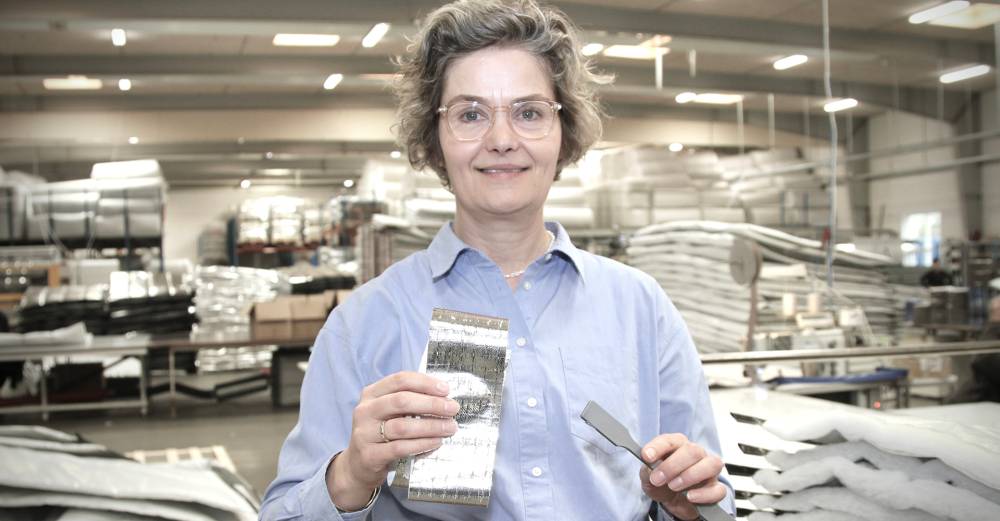Sustainable strategy: Production waste can be recycled

Combitherms new sustainability strategy is already bearing fruit. We have changed the processes, and this results in, among other things, an optimised cutting of foils to reduce waste - waste that can also be recycled.
It is relatively ‘easy’ to decide on a sustainable strategy at a company – it is when it comes to the execution of the strategy that things start to get complicated.
Nevertheless, Combitherm A/S has decided to do something to be more sustainable:
“It is not like we can just suddenly call all our products or our company sustainable. For us, it is very much about our interactions with other companies in the value chain. That means suppliers, customers and other business partners,” says Charlotte Qvist Jørgensen, Product Manager at the company.
Processes are crucial
“Among other things, we are looking at our processes and the possibilities to optimise. Are there areas where we can organise our work differently to save energy? We look at the materials and waste. It is the many small streams principle, where over time we tune and adjust the variables that together make up an overall strategy, which then becomes more sustainable,” says Charlotte.
In principle, nothing is sacred, and everything can be adapted and changed for the better.
“Our products are based on a three-layer construction consisting of an outer foil, insulation material and inner foil, which is why we use large quantities of different types of foils when making our thermal solutions. We have looked at whether we can cut out the foil to reduce waste and whether the existing waste can perhaps be recycled and upcycled for another purpose,” Charlotte says.
Foil becomes plastic
A specific example is a metallised foil that the company uses in its insulating thermal covers.
“Here, we can reduce the amount of residual foil by cutting it in a way that makes the most efficient use of it. At the same time, we have realised that the production off-cuts can be recycled and live on as an entirely different product. The residual foil can be transformed into a plastic product with high inherent strength that can be used as a material in other products made of plastic,” says Charlotte, and concludes: “By changing our processes, we can achieve significantly less residual waste from production, and we can take a step further in our sustainable development and the journey towards a more circular business model.”
This is in line with another of the company’s products, the insulation material used as a filler in its products. Polywool®, as the material is called, is based on 78% recycled fibres from recycled plastic from water bottles.
A dynamic process
Becoming more sustainable is not a constant but an ongoing, dynamic development.
“We will never stop moving in the right direction, which is also true when working with our customers and suppliers because what do customers do when they have finished using our product? Here we need to develop collaborations that allow the product to have a new life,” Charlotte says.
“It is important that the decision to adopt a sustainability strategy is not overly preconceived. The work cannot be done in a week, but it is important to get started. Taking small steps will create good solutions and successes along the way, eventually forming a whole. The interaction with the other value chain actors also helps motivate and push each other in the right direction,” says Charlotte Qvist Jørgensen.
World-class temperature control
Combitherm is amongst the leading European manufacturers of flexible, tailor-made and energy-saving thermal solutions for a wide range of industries working with temperature-sensitive products and processes and where temperature fluctuations must be kept to a minimum.
Our products include thermal covers, concrete duvets, winter mats, asphalt duvets, blade covers, truck partitions as well as insulating mats, all of which are important elements when the cold chain needs to be secured during transport and storage of e.g., foods and medicine or when casting and curing processes needs to be stabilised within the wind turbine and building & construction industries.
Further information
Questions can be directed to COO Torben Hallstrup at th@combitherm.dk or +45 2334 0180.
Photo: Charlotte Qvist Jørgensen, Product Manager at Combitherm, shows an example of how a product, namely a metallised foil residue, can be transformed into an entirely new sheet product that proves to have excellent properties for many purposes.

